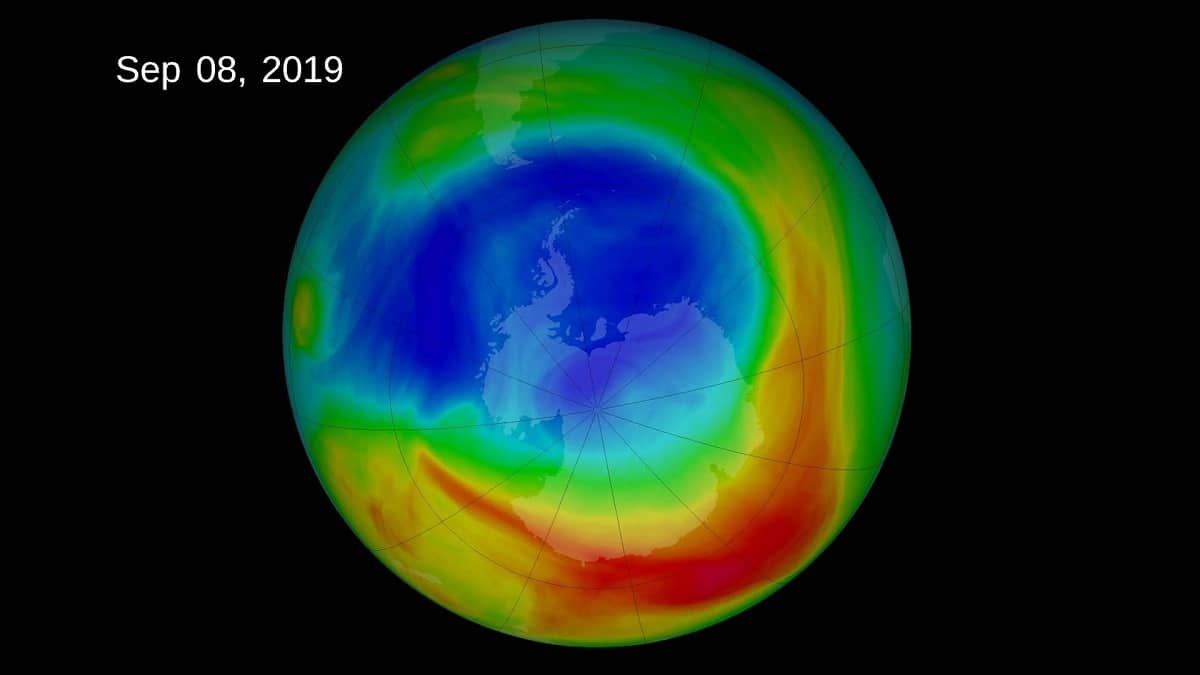
The ozone layer is the area where the treatment will be where the ozone concentration is higher than normal. This layer protects us against harmful ultraviolet radiation from the sun. However, the emission of some chemical substances known by the name of chlorofluorocarbons a has caused a hole in the ozone layer. This hole has been known for decades and is shrinking thanks to the Montreal protocol.
In this article we are going to tell you everything you need to know about the hole in the ozone layer.
Definition of the ozone layer

Let's first get to know what the ozone layer is. It is a kind of protective layer that is located in the stratosphere. This layer acted as a filter for ultraviolet solar radiation that is harmful to living beings. It does not serve as a shield against this ultraviolet radiation in a way that guarantees life on earth as we know it today.
Despite the fact that this layer is very important for survival, it seems that human beings are still determined to destroy it. Chlorofluorocarbons They are chemical substances that through various reactions destroy the ozone present in the stratosphere. It is a gases composed of fluorine, chlorine and carbon. When this chemical reaches the stratosphere, it reacts photolytically with ultraviolet radiation from the sun. This causes the molecule to break down and they want chlorine atoms. Chlorine reacts with ozone in the stratosphere, causing oxygen atoms to form and breaking down ozone. In this way, the emission of these chemicals is continuously causing the destruction of the ozone layer.
Furthermore, it must be taken into account that these chemicals have a long useful life in the atmosphere. Thanks to the Montreal protocol, the emission of these chemicals was totally prohibited. However, to this day, the ozone layer is still damaged. The hole in the ozone layer is noticeably improving over previous decades. Let's analyze this more deeply.
Hole in the ozone layer

Ozone is located in the stratosphere at a height between 15 and 30 kilometers. This layer is made up of ozone molecules that is, in turn, composed of 3 atomic oxygen atoms. The function of this layer is to absorb ultraviolet B radiation, serving as a filter to reduce damage.
The destruction of the ozone layer occurs when there are chemical reactions that cause the destruction of this stratospheric ozone. The incident solar radiation is filtered by the ozone layer and it is where the ozone molecules break down through ultraviolet B radiation. When this happens, the ozone molecules dissociate into oxygen and dioxide. This process is called photolysis. It means the breakdown of a molecule by the action of light.
The forms of dioxide and oxygen are not completely dissociated, but rejoin, forming ozone again. This step does not always happen and it is what causes holes in the ozone layer. The main causes for those that destroy the ozone layer at an accelerated rate is by the emission of chlorofluorocarbons. Although we have mentioned that the incident light from the sun destroys ozone, it does so in such a way that the balance is neutral. That is, the amount of ozone that is broken by photolysis is equal to or less than the amount of ozone that is capable of being formed by association between molecules.
This means that the main cause of the breakdown of the ozone layer is due to the emission of chlorofluorocarbons. The World Meteorological Organization affirms that the recovery of the ozone layer will take place around the year 2050 thanks to the prohibition of these products. Keep in mind that all of these are estimates since, even if these chemicals are discontinued, they remain in the atmosphere for decades.
Consequences of the hole in the ozone layer

Notably, the ozone hole is mainly over Antarctica. Despite the fact that most of the gases harmful to the ozone layer have been emitted in developed countries, there is an atmospheric current that carries these gases towards Antarctica. Also, to this we must add the time that these gases remain in the atmosphere and that they are capable of damaging ozone.
Thanks to the general circulation of the planet, these gases have benefited from the low temperatures in the southern hemisphere and have largely broken this concentration of ozone. And it is that the destruction of said layer if it accentuated the lower the temperature. This causes the drop in ozone concentration to increase in winter while it recovers in spring.
There are various consequences of the deterioration or destruction of the ozone layer. We will analyze what they are depending on who they affect.
Consequences for human health
- Skin cancer: It is one of the most well-known diseases related to exposure to ultraviolet B radiation. It is necessary to sunbathe with protection since the disease does not appear at the moment, but over the years.
- Immune system affection: Acting on the organism gradually reduces the capacity to protect ourselves against infectious diseases.
- Vision disturbance: it can lead to cataracts and presbyopia more often.
- Respiratory problems: Some problems are asthma due to the increase in ozone in the lower layers of the atmosphere.
Consequences on terrestrial and marine animals
It negatively affects all land animals and has similar consequences to humans. As for marine fauna, this radiation reaches the surface in a way that directly affects the phytoplankton in the oceans. This phytoplankton has their populations reduced to such an extent that it affects the food chain.
Consequences on plants
The incidence of this most harmful ultraviolet radiation affects the development of plant species, causing their flowering and growth times to vary. All this affects the reduction of the populations of plants and crops.
I hope that with this information you can learn more about the hole in the ozone layer.